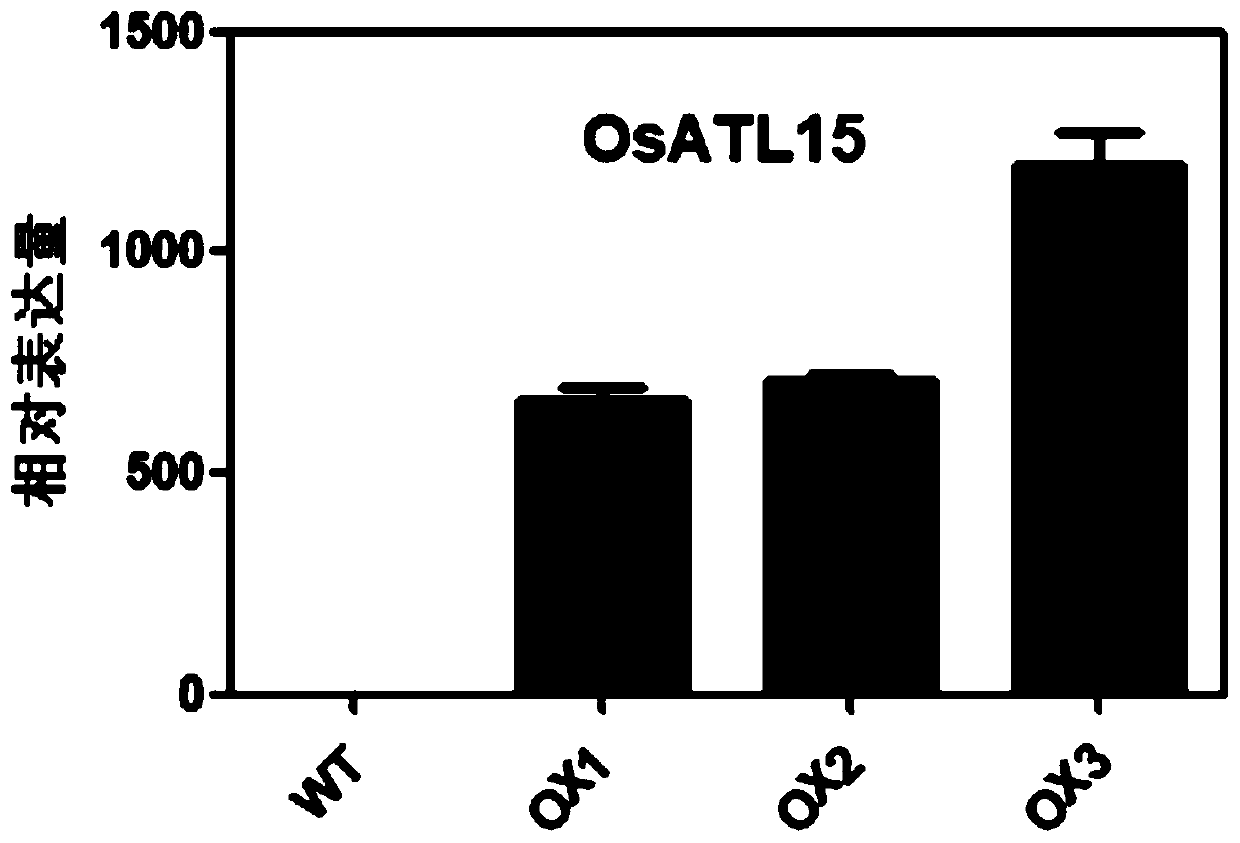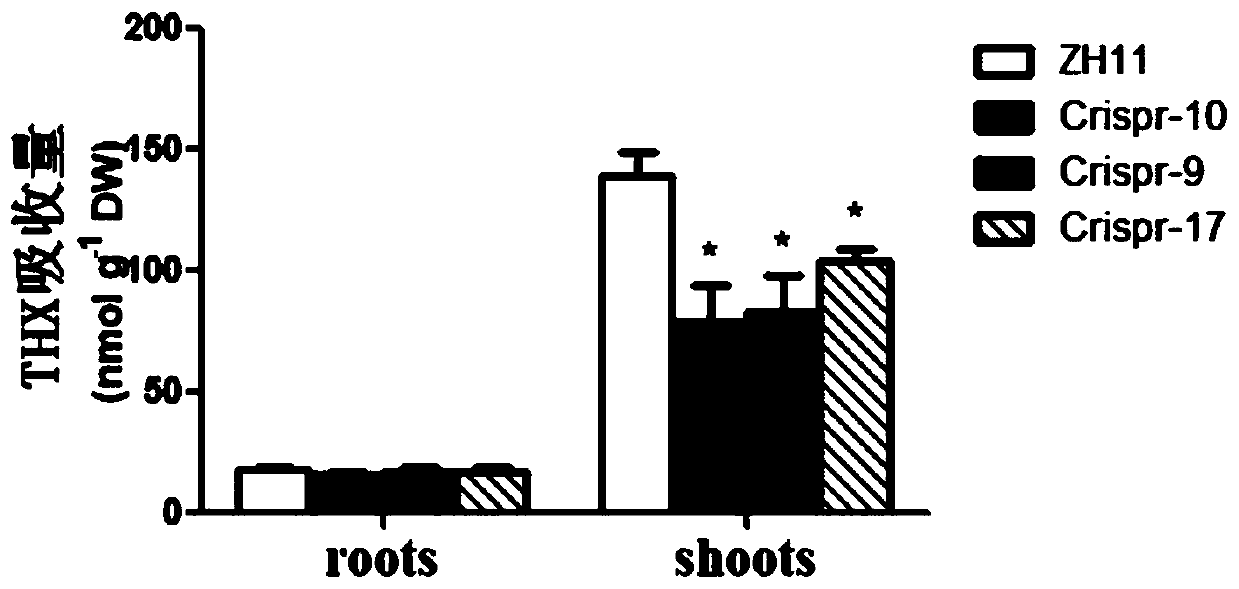Application of rice gene OsATL15 in regulating absorption and transport of pesticides
A rice and genetic technology, applied in application, genetic engineering, plant genetic improvement, etc., can solve the problems of loss, low utilization efficiency and decline of chemical fertilizers and pesticides, and achieve the effect of reducing the amount of use
- Summary
- Abstract
- Description
- Claims
- Application Information
AI Technical Summary
Problems solved by technology
Method used
Image
Examples
Embodiment 1
[0057] Cloning of embodiment 1 OsATL15 gene and its encoded protein
[0058] The RNA (OMEGA R6827-01) of the wild-type japonica rice variety Zhonghua 11 seedlings was extracted, reverse-transcribed (Takara cat#6210A) to obtain gDNA-free cDNA (with the nucleotide shown in SEQ ID NO: 1), and its As a template, PCR amplification was performed using forward primer F1 and reverse primer R1. A PCR product of 1896bp was obtained.
[0059] After sequencing, the 1896bp PCR product has the nucleotide shown in SEQ ID NO:2. Use (http: / / web.expasy.org / translate / ) to perform amino acid translation on the coding sequence CDS, and obtain the amino acid sequence of OsATL15, which encodes 631 amino acids. The encoded protein is named OsATL15, and the amino acid sequence of the protein is shown in SEQ ID NO:3.
[0060] F1: 5'-ATGGCAGATCAGAAGGTG-3';
[0061] R1: 5'-TCATAGGTGACGAGACTGAGGTG-3'.
Embodiment 2
[0062] Example 2 Construction of Overexpressed OsATL15 Plants
[0063] 1. Overexpression of OsATL15 gene
[0064] 1. Construction of recombinant expression vector pCAMBIA1300-35S-OsATL15
[0065] Extract the RNA of wild-type Zhonghua 11 seedlings, reverse transcribe to obtain cDNA as a template (extraction and reverse transcription methods are the same as in Example 1), use primer 1 (ACCCGGGGATCCTCTAGAGTCGAATGGCAGATCAGAAGGTG) and primer 2 (ATGATACGAACGAAAGCTCTGCATCATAGGTGACGAGACTGAGGTG) to carry out PCR amplification (Takara cat #R045), the reaction conditions are: 1 cycle: 98°C, 3min; 32 cycles: 98°C, 30s, 58°C, 30s, 72°C, 1min; 1 cycle: 72°C, 5min; 15-base homologous recombination arm of the OsATL15 gene.
[0066] The above PCR products were gel-recovered, and homologously recombined with the pCAMBIA2300-35S vector backbone (provided by Wuhan Boyuan Company) that had been digested with Sal I and Pst I through the In-fusion kit (Takara cat#639648) to obtain recombinant pla...
Embodiment 3
[0095] Example 3: CRISPR knockout construction of OsATL15 mutant plants
[0096] 1. Use the CRISPR / Cas9 system to select the target sequence according to the exon sequence of OsATL15
[0097] Using the simple and efficient CRISPR / Cas9 system, select the specific target sequence according to the OsATL15 exon sequence, the target sequence: GAGGCACGTCCTGGAGAAGGAGG. The target sequence is aimed at the OsATL15 gene and specifically inactivates the OsATL15 protein.
[0098] 2. Construct the pCRISPR / Cas9 recombinant vector containing the above target sequence fragment
[0099] 1) According to the target sequence, design adapter primers with sticky ends
[0100] Add the designed target sequence to the specific sticky end adapter (F: GGCA; R: AAAC) of the pCRISPR / Cas9 system, and synthesize the complete adapter primer.
[0101] F3: 5'-GGCA-GAGGCACGTCCTGGAGAAGG-3';
[0102] R3: 5'-AAAC-CCTTTCTCCAGGACGTGCCTC-3'.
[0103] 2) Annealing the adapter primer with sticky ends to complement...
PUM
 Login to View More
Login to View More Abstract
Description
Claims
Application Information
 Login to View More
Login to View More - R&D
- Intellectual Property
- Life Sciences
- Materials
- Tech Scout
- Unparalleled Data Quality
- Higher Quality Content
- 60% Fewer Hallucinations
Browse by: Latest US Patents, China's latest patents, Technical Efficacy Thesaurus, Application Domain, Technology Topic, Popular Technical Reports.
© 2025 PatSnap. All rights reserved.Legal|Privacy policy|Modern Slavery Act Transparency Statement|Sitemap|About US| Contact US: help@patsnap.com



